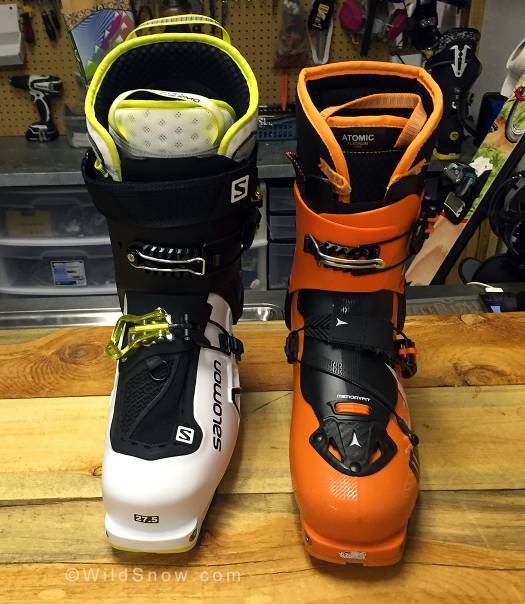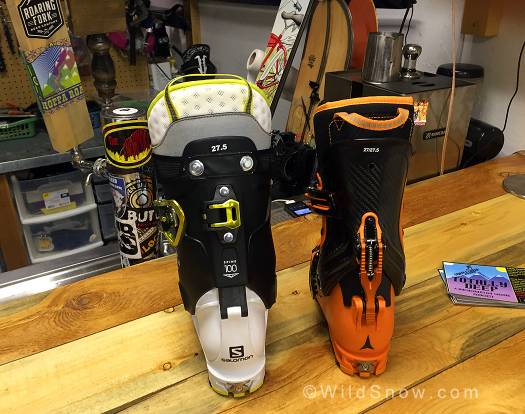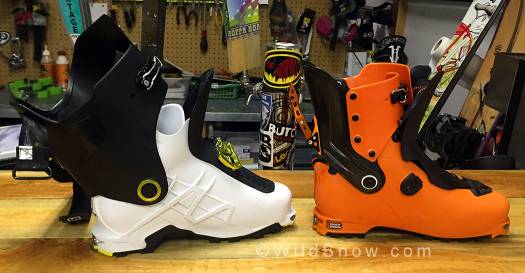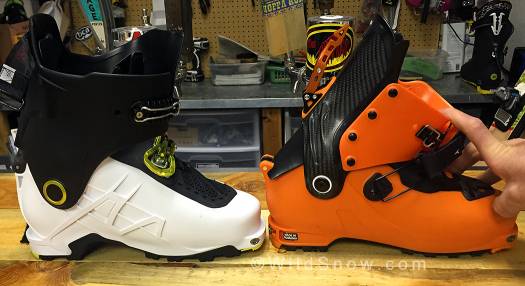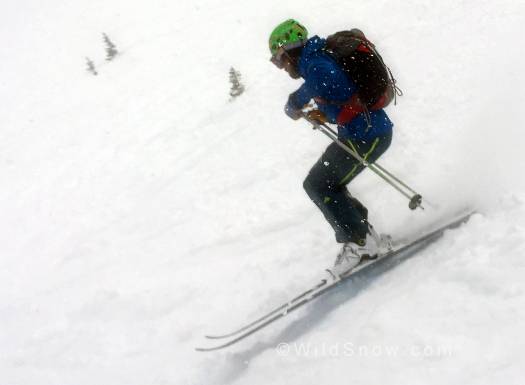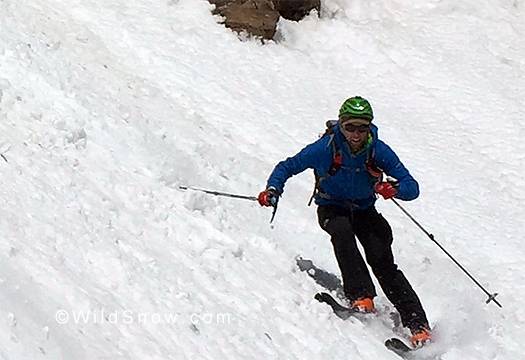I’ve been working with WildSnow on different types of gear comparisons. The situation is perfect. Our shop, Cripple Creek Backcountry, is only a short bicycle ride from Lou’s office. So we’re not only sharing evaluation gear but we can sit down in person and work on editorial concepts over an espresso or six-string.
This time, let’s go for a bit of contrast in our gear chatter. Although the Atomic Backland Carbon Light and Salomon MTN Explore are somewhat different types of touring boots they are the lightest in their respective families. They also represent a somewhat new chapter in ski touring gear, as two pretty much “historic” alpine boot manufacturers have finally gotten it right and designed backcountry ski boots with more than just a walk mode for the parking lot.
(Yes, it would make sense to compare the Atomic Backland Carbon with the Dynafit TLT6 Performance. After all, the boots are within 50 grams weight of each other and possess many of the same features. Do we feel another comparo coming on?)
Companies: Both boot makers were absorbed by the mega outdoors company Amer Sports in the last 25 years, but managed to keep their uniqueness in touring boot design. Salomon was founded in French Alps in 1947 and acquired by Amer Sports in 2004. Atomic is an Austrian company founded in 1955 and acquired by Amer in 1994.
Weights: Carbon Light comes in at 20% lighter than other boots of its class while the MTN Explore comes in much heavier. You can debate comfort and ease of touring as compensating somewhat for added weight (just listen to the sales rep pitch), but the scale doesn’t lie. Salomon MTN Explore is 1462 grams; Atomic Backland Carbon Light comes in at 1065 grams (without removable tongue).
Buckles: Remember when everyone wanted 4 buckles on a boot? While the industry still categorizes and sells boots as “4-buckle!” we shy away from describing boots by the number of buckles. Really, if the boot fits and skis, who cares how many buckles it has. In any case, MTN Explore has 2 buckles and a power strap, while Carbon Light has 2 buckles and an optional power strap. Note that Atomic adds a wire pressure distribution system to the lower buckle; necessary if you run without the tongue.
Design: Both boots have excellent range of cuff-walk motion with a one-flick walk mode that tours adequately without loosening the buckles (and even better with the buckles loosened or opened, as with nearly any other touring boot). Both boots have top buckles that fit neatly against the cuff and under your ski pants.
Shell design type: MTN Explore is an alpine overlap style boot with internalized walk mode in the heel. Atomic Carbon Light is a lightweight tongue styled AT boot with an external walk-ski lever similar to many other ski touring boots.
Cuff articulation: MTN Explore has a good 62 degrees, but mostly in the rearward direction. That’s fine for mountain touring, but having more forward range is helpful when you really stride out in terrain with mixed angles. Carbon Light gives you 74 degrees of cuff motion biased to the front though you get plenty of rearward range as well. In terms of learning from this comparison, the cuff flex difference between an overlap boot and tongue type boot is an obvious contrast and area of compromise. Put simply, the overlap as a rule will ski more “alpine like” than the tongue boot.
Liners: Salomon MTN Explore has a beefier (and heavier) liner that’s still plenty warm. Atomic Carbon Light offers a feather light heat moldable liner and the shell molds to some degree when heated per Atomic’s fit specifications. (More about the ‘Memory Fit’ heat molding process.) The Atomic liner has “breathability” features that help reduce moisture buildup, but as with other boot boasting breathable liners your mileage may vary due to the reality of a non-breathing shell. Atomic also states their liner is “washable,” but in our experience you can wash any boot liner if you do it gently by hand in warm (not hot) water, and dry with an air blower boot dryer.
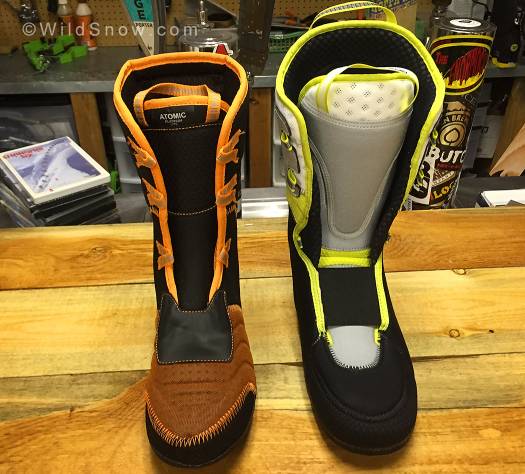
Notice the ventilation holes on the orange Carbon Light compared with the added girth for warmth on the MTN Explore.
Fit: To give you some background, I wear a size 10.5 street shoot, yet my foot measures 106mm in its widest part. Although I am not a downhill racer (or even a great skier) I can still comfortably jam my foot into a 26.5. For these two boots I did upsize into a 27. Both boots have done away with the myth of the half size. The 27.0/27.5 is the same exact boot and neither one calls it any different.
Don’t be fooled by the MTN Explore claimed 98mm last. I still swam in the size I tested — if I ski it this year I would definitely downsize. The boot felt high volume especially above the instep. All this business about last size (“98mm low volume high performance!”) being used as a sales tool is often B.S.; the boot fits, or it doesn’t. If not, you change sizes or brand-model, and you work with a boot fitter if necessary.
Carbon Light was comfortable out of the box for me, I never heat molded the liner or shell. My business partner Randy also uses a size 27 and went through the whole molding process. One day I accidentally grabbed his boots and went swimming again, proof that the molding process does work. Note that the Atomic mold process seems to be a one way street and results in more shell volume, so if you are going to bake the shells be very careful with your sizing.
How to pair with skis
Salomon MTN Explore: This boot toured wonderfully despite being a “heavy boot.” I paired it with the heaviest ski in our whole collection, the Kastle TX107 (I use “heavy” as a term of art, as both the skis and boot are still quite light by some standards). I did a couple days of true backcountry ski touring, but I also took the boot to the resort. When it dumps and the backcountry gets scary it is time to uphill at Aspen Highlands. The boot skinned well, crushed the Highlands Bowl hike and drove the 107mm wasted ski with no problem. If you are a 50/50 skier in and out of the area, this is going to be a terrific boot.
Atomic Backland Carbon Light: This boot was the ski mountaineering machine for me last spring. I skied steep lines matched with a pair of Atomic Ultimate 78s for corn farming. I went as wide as a pair of DPS Wailer 99s for our local resort closing party and skied them in bounds. Although this was a lot of ski for a light boot on hard snow, for powder slarving the Backland Carbon Light would definitely do the job with a ski up to around 100mm width.
There you go, an experiment in comparison we hope will help with shopping decisions and overall knowledge of what’s out there in ski touring boots.
Doug Stenclik is an avid skimo racer and ski mountaineer who lives for sharing the amazing sports of ski touring and splitboarding. Since his first time on skins he was hooked and the obsession has taken him all over the United States and the world pursuing the human powered ski turn. He founded Cripple Creek Backcountry in 2012 and took over the Colorado Ski Mountaineering Race Cup in 2014 to spread knowledge and the love of the sport. In 2019 he took a step back from the ski shop and race promoter life to become a publishing partner with WildSnow.

